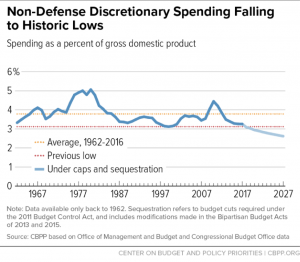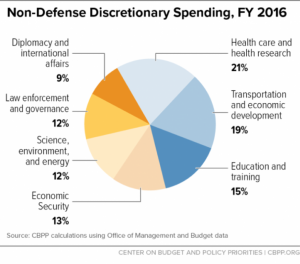March 29, 2019
Sequestration is back; and science funding is in jeopardy.
Posted by bwebster
The Budget Control Act of 2011 (BCA) required Congress to find ways to cut the deficit by capping funding for non-defense, including science, and defense programs. Congress never came to an agreement on ways to cut the deficit and therefore automatic across the board cuts for government spending, or sequestration, were invoked. Sequestration was supposed to be so bad that Congress would be forced to reach an agreement. Under the BCA, FY2020 defense spending must be cut $71 billion, and non-defense discretionary spending must be cut by $55 billion. This is bad news for all federal agencies that support research and technology.
Parity between Defense and Non-Defense is Vital for Strong Science Funding
Under the Budget Control Act, there’s a limit to how much money Congress is allowed to spend through the appropriations process. The parity principal ensures that funding for non-defense programs (including funding for federal science agencies) is increased by the same amount as funding for defense programs.
Increasingly, the federal budget is dominated by spending on mandatory programs, like Social Security, Medicare, and interest payments on the national debt. This shrinks the size of the pie available to Congress to allocate through the appropriations process. In order for science, and other non-defense programs to see any growth in funding it is imperative that Congress continue to require parity between defense and non-defense programs in the appropriations process.
It’s Time to Raise the Caps
Sequestration budget caps hold America back. Increased funding in critical federal agencies and programs helps strengthen national security, grow the economy, and advance the United States’ ability to perform cutting-edge research.
Members of Congress Like Science but Need A Reason to Protect It
When meeting with Congressional offices, the most common refrain we hear is encouragement to keep reaching out to other members, especially members who do not sit on committees that handle science. Members who sit on committees whose jurisdiction includes science, often develop an appreciation for science and understand the need for continued government investment in science, even without clear payoffs. However, what about the majority of legislators who don’t?
Those are the members of Congress who need attention. Overwhelmingly, we hear from offices that they love science, think it’s cool, and can’t wait to see what will be discovered next. But how do we turn that enthusiasm into increased investments and higher prioritization of science? By repeatedly meeting and highlighting how science is critical for the legislator’s district and constituents; by making science real and tangible for lawmakers.
You Can Take Significant Actions Now
Budget decisions are being made right now, and we need you! Below find some easy ways to make your voice heard:
- Add your name to Research America’s Raise the Caps Petition.
- Reach out to your member of congress and tell them to raise the caps and support science funding! Meet with your representative or their staff, call them, attend one of their events in the district, or write them a letter. No matter how you reach out to your member of Congress, you should identify yourself as a constituent, discuss how science and your work benefits your local community and the nation, and why robust funding for science is essential for your work and our nation’s scientific endeavor.
- Tweet using the hastag #RaiseTheCaps to leadership in the House and the Senate or post to Facebook.
You can find resources to tailor your message from AGU or Research America.





